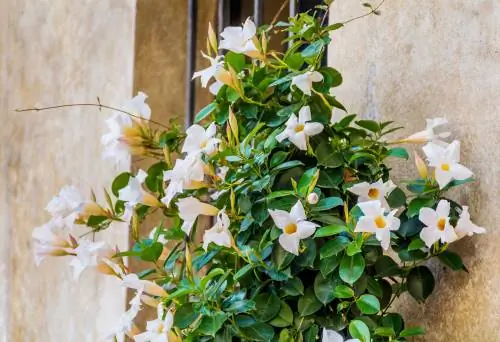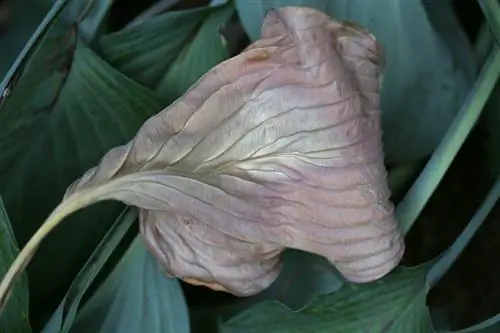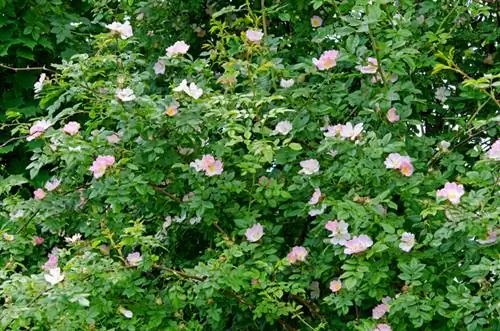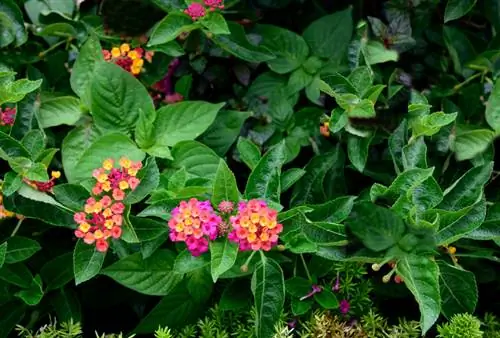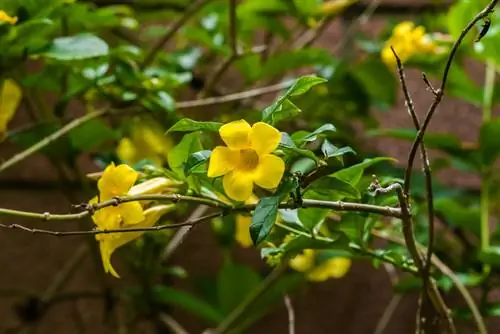- Author admin [email protected].
- Public 2023-12-16 16:46.
- Last modified 2025-06-01 06:02.
Sun-drenched locations in and around the house transform the exotic Dipladenia into a summery sea of flowers. When climbing roses and clematis languish on sweltering southern facades, the opulent Dipladenia varieties shine in their most beautiful blossoms. In the temperate winter garden, the floral beauties add decorative accents all year round. With careful pruning care, you can encourage the magnificent climbing artists to perform at their best. This tutorial will guide you through the best pruning care for Mandevilla in a practical and understandable way.
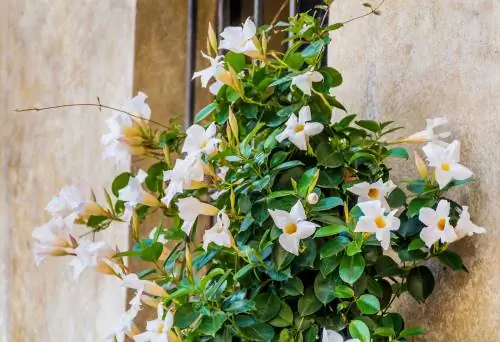
How do I cut a Dipladenia for optimal flowering?
Pruning Dipladenia is important to promote bushy growth and abundance of flowers. Prune young plants several times after potting, carry out maintenance pruning in March/April, and prune for shape corrections during flowering. You can prune before winter quarters.
Why does pruning make sense?
High-quality dipladenias grown by master craftsmen do not require pruning. Thenon-hardy climbing plants celebrate the flower festival from early summer to autumn and say goodbye never again after the first frost.
If suitable winter quarters are available, experienced home gardeners opt for multi-year cultivation. Proud owners of a temperature-controlled winter garden can look forward to the picturesque funnel flowers all year round. Under these circumstances, pruning care comes into focus. This table summarizes all options for a cut with tips for the best time:
| Cut style | Goal/Occasion | best time |
|---|---|---|
| Depointing | bushy growth of young plants | several times after potting |
| Conservation cut | Promote abundance of flowers | March/April, before budding begins |
| Topiary | shorten tendrils that are too long, clean out wilted flowers | during the flowering period |
| pruning | cutting if there is a lack of space in the winter quarters | before putting away |
Pruning young Dipladenia - this is how it works
Small young plants that have been propagated at home or purchased cheaply consist of a few, long shoots. To ensure that a young, sparsely branched Dipladenia grows bushier, the shoot tips are removed. In technical jargon, the gardening trick is referred to as trimming or tweezing. Scissors are not absolutely necessary. How to properly de-tip a Mandevilla:
- The best time is once or twice during budding
- Put on thin disposable gloves that allow for some dexterity
- Grasp the shoot between your thumb and forefinger just below the top pair of leaves
- Break off to the side or pinch off with your fingernails
Since it has lost its top buds, the tweezed Dipladenia turns to its reserve buds in the lower part of its tendrils. Increased sprouting of side shoots begins, which bear numerous flower buds in summer.
Background
Detipping circumvents tip bud dominance
Dipladenia's genetic blueprint stipulates that growth towards the sky has priority. For this reason, the plant pumps reserve substances with all its might towards its top buds. Pruning destroys the floral project and directs the growth forces into side buds and sleeping eyes, which then sprout happily. By removing the top buds once or twice on a young Mandevilla, you will encourage bushy growth with this year's shoots bearing numerous flower buds. You can also take advantage of the growth law of peak promotion when overwintered dipladenias begin to sprout after a vigorous pruning.
Maintenance cut - start of the flowering period
For dipladenias that have been cared for over several years, the time window for maintenance pruning opens at the end of the winter rest phase. The exotic climbing plants produce the most flower buds on this year's shoots, so pruning last year's dead tendrils is an advantage. It is up to your individual assessment to what extent a maintenance cut is carried out. We have put together all the options for a skilful cut for you below:
- Strong cut: Remove the tendrils from the climbing aid and cut back to 2 buds or pairs of leaves
- Medium cut: loosen the tendrils and shorten them by half
- Easy pruning: cut back shoots hanging from the trellis
Please always cut within a short distance of a conveniently positioned pair of leaves. If your Dipladenia has shed its leaves in winter quarters, cut a few millimeters above a leaf node that points in the desired direction of growth. For maintenance pruning, you then tie detached tendrils to the trellis again. Mandevilla species do not have adhesive organs like ivy. The creepers therefore depend on your help to grow up a trellis.
Tip
If regularly tying long tendrils to a climbing aid is too annoying, cultivate a Dipladenia as an hanging basket plant. The creeper only grows upright where a climbing aid is available. Planted in a hanging basket, the exotic beauty lets its long shoots dangle casually and full of flowers.
Cut every now and then in summer
Dipladenia is one of the self-cleaning flowering plants. In concrete terms, this means that the plant sheds withered flowers on its own. Regular cleaning, as with garden hibiscus or phlox, is not necessary for a well-groomed appearance. However, the Mandevilla takes plenty of time for the process because it aims to form seed heads for propagation. If you shorten tendrils that are too long in summer anyway, dried inflorescences should be removed at the same time. So your Dipladenia remains a feast for the eyes in summer:
- Clean out wilted flowers as soon as possible to prevent seed heads from forming
- Only cut back shoots that are too long and out of shape if necessary
- Place scissors just above a pair of leaves or a bud
Please carefully consider pruning long vines in the middle of summer. On one of this year's shoots, a Dipladenia is laying the buds for colorful funnel flowers. It's better if you wrap a valuable vine around the climbing aid and tie it there.
Excursus
Bypass scissors versus anvil scissors
Dipladenia species and varieties cultivated in our regions do not become woody. Rather, the climbing plants thrive with thin, herbaceous and flexible tendrils. One-handed secateurs with a bypass mechanism are perfect for pruning care. The scissors are equipped withtwo sharp blades that pass each other when you squeeze the handle. This leaves the smoothest possible cuts. Anvil scissors work with one sharp and one blunt side. If the sharp blade presses the shoot against the anvil, there is a risk that the tendril will be crushed and not cut smoothly.
Lack of space in the winter quarters? - Pruning
A lovingly cared for Dipladenia reaches majestic sizes of up to 300 centimeters. Not every winter quarter is suitable for these expansive dimensions. Before you dispose of the busy summer flower in the fall due to lack of space, cut the plant back before putting it away. Take this opportunity to remove wilted flowers and dried leaves. Please limit the amount of cutting to a minimum. The central maintenance cut is carried out at the end of the winter break, shortly before budding begins.
Milk juice is flowing in streams - what to do?
Dipladenia is characterized by a milky-white plant sap. In connection with a pruning, thepoisonous secretion comes out. The larger a cut, the more abundant the sticky milky sap flows, dripping onto lower-lying leaves and the ground. Contact with skin can cause itchy eczema. Milky sap causes stubborn stains on clothing, carpets and natural stone. Sticky drops mar the shiny, evergreen decorative leaves. It is therefore advisable to take the following precautions before each cut:
- Put on gloves with cuffs
- Cover clothing with an apron or plastic overalls
- Crop Dipladenia outside
- Alternatively, protect the floor with foil or old blankets
Before you start cutting Mandevilla, tear up paper tissues and form small balls out of them. After each cut, quickly cover the wound with a ball of paper. Cotton balls are also good for intercepting the flow of sap.
Frequently asked questions
Can a Dipladenia overwinter outside?
Dipladenias are generally not hardy. The minimum temperature is 5 degrees Celsius. For this reason, climbing plants in our latitudes are mostly cultivated as annuals. After the first frost at the latest, the plants die completely, including the root system. Overwintering the Dipladenia outdoors is not possible, even with extensive protective measures. The only exception applies to Chilean jasmine (Mandevilla laxa). In a pot or planted in mild winter wine-growing regions and equipped with winter protection, the climbing plant can survive temperatures between -5 and -10 degrees Celsius.
Are Dipladenia varieties poisonous?
The botanical classification of the dog poison family already suggests this. Dipladenia varieties are poisonous to humans and animals. The exotic creeper is permeated by a white, poisonous milky sap. Intentional or unintentional consumption of leaves, flowers or capsule fruits causes severe nausea and vomiting. Skin contact with the white plant sap can cause allergies and eczema. Please always cultivate Mandevilla out of the reach of children and pets. Always wear gloves with cuffs when caring for and cutting work.
At what temperature should a Mandevilla be overwintered?
From the beginning to mid-October it is too cold for a Mandevilla on the balcony or in the garden. If the temperatures fall below 10 degrees at night, move the exotic climbing beauty to its bright, frost-free winter quarters. At temperatures between 8 and 12 degrees Celsius there are good prospects of overwintering undamaged. Cozy, warmly heated living spaces with temperatures well over 20 degrees Celsius are not suitable because the combination of heat and lack of light ruins every Dipladenia. With a little luck, a slightly temperate winter garden with a maximum of 18 degrees Celsius will encourage a Mandevilla to bloom all year round.
Do the terms Dipladenia, Mandevilla and Sundaville refer to different plant species?
There are a variety of names and trade names circulating around the genus Dipladenia. Mandevilla is common as a synonym for the genus name, sometimes in the French spelling Mandeville. The name Sundaville hides one of the most beautiful Dipladenia varieties with fire-red funnel flowers. Further trade names complete the botanical Tower of Babel, with dipladenias sometimes being offered as Chilean jasmine or false jasmine, due to the similar flower shapes.
Can I use the cuttings of a Mandeville for propagation from cuttings?
That's entirely possible. He althy head cuttings with at least three pairs of leaves are best. Cut a cutting to a length of 10 to 15 centimeters and remove all leaves except for the pair of leaves at the top of the shoot. If flower buds are already present, these are also removed. Place two thirds of a cutting in a pot with lean potting soil and water. A transparent hood promotes rooting in a bright, warm location. Use wooden sticks or long matches as spacers to prevent the cover from coming into contact with the cutting.
The 3 most common cutting mistakes
Typical pruning errors mean that a Dipladenia does not bloom after overwintering or is affected by diseases after pruning. The following table lists the three most common breakdowns in Mandeville's average and provides tips for prevention:
| Cutting errors | malicious image | Prevention |
|---|---|---|
| never cut | fewer flowers from year to year | prune every spring |
| cut too late | few or no flowers at all | cut in time before growth begins |
| unclean scissors | Infection with diseases and pests | Always clean and disinfect scissors in advance |

Tip
Popular Dipladenia varieties for balconies and terraces form thick, turnip-shaped roots. The roots act as storage organs for water and nutrients. Mandevilla is therefore the ideal plant for gardeners who are short on time. The watering requirement is limited to average intervals of 8 to 10 days, without affecting the furious blossoms. It is important to note that the exotic climbing plants are primarily watered with soft rain or stale tap water.

